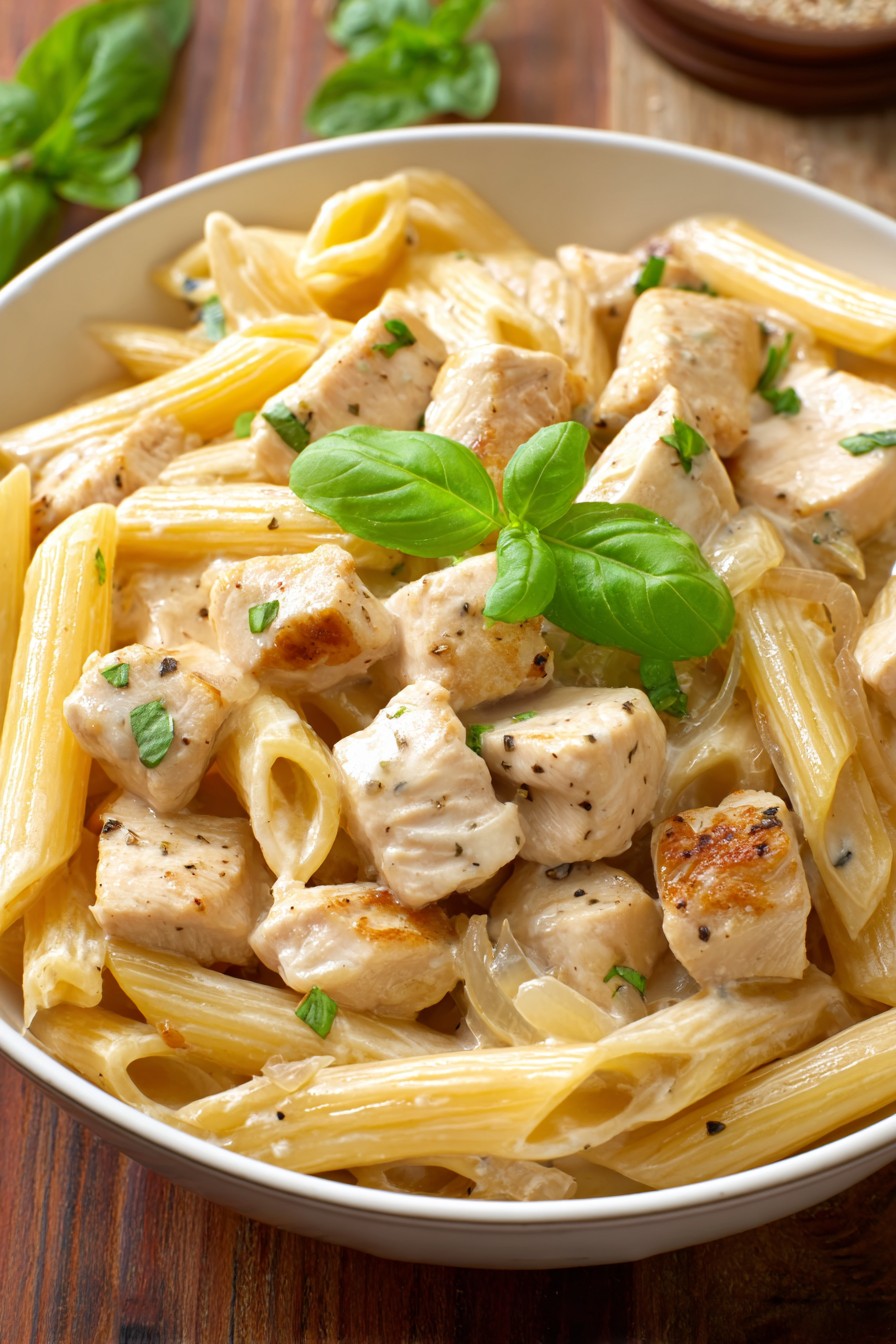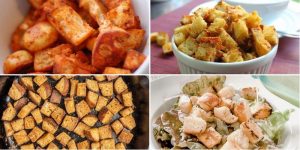Ready to transform your dinner routine with a dish that delivers maximum flavor with minimal fuss? Really, this chicken penne pasta recipe is about to become your go-to for busy nights when you crave something comforting yet impressive. Remember those days when takeout seemed like the only option? Well, kiss those goodbye because this homemade version will have you feeling like a culinary rockstar without the hefty price tag or mysterious ingredients.
Why This Recipe Works
- The combination of tender, seasoned chicken breast cooked to golden perfection provides a protein-packed foundation that absorbs the creamy sauce beautifully, ensuring every bite is juicy and flavorful rather than dry or bland.
- Using penne pasta, with its tube-like shape and ridges, acts as little sauce catchers that hold onto the creamy Parmesan and herb mixture, delivering an explosion of flavor in every single forkful rather than letting it slide right off.
- Simmering the sauce with a splash of chicken broth and heavy cream creates a luxuriously smooth texture that coats each ingredient evenly without becoming greasy or separating, thanks to the gradual incorporation and constant stirring technique.
- Finishing with fresh basil and a squeeze of lemon juice right at the end brightens up the rich elements, cutting through the creaminess with a refreshing zing that elevates the entire dish from simple to spectacular.
- The one-pan approach (minus boiling the pasta) means fewer dishes to wash and more time to enjoy your meal, making it practical for weeknights while still feeling special enough for casual entertaining.
Ingredients
- 1 pound boneless, skinless chicken breasts, cut into 1-inch cubes
- 12 ounces penne pasta
- 3 tablespoons olive oil, divided
- 4 cloves garlic, minced
- 1 small yellow onion, finely diced
- 1 cup heavy cream
- 1/2 cup chicken broth
- 1 cup grated Parmesan cheese, plus extra for serving
- 2 teaspoons Italian seasoning
- 1/2 teaspoon red pepper flakes (optional)
- Salt and freshly ground black pepper to taste
- 1/4 cup fresh basil leaves, chopped
- 1 tablespoon fresh lemon juice
Equipment Needed
- Large pot for boiling pasta
- Large skillet or Dutch oven
- Colander
- Cutting board and sharp knife
- Measuring cups and spoons
- Wooden spoon or spatula
- Grater (if using block Parmesan)
Instructions

Step 1: Cook the Pasta to Al Dente Perfection
Fill your large pot with about 4 quarts of water and bring it to a rolling boil over high heat—you’ll know it’s ready when large bubbles vigorously break the surface. Add a generous tablespoon of salt to the water; this is your only chance to season the pasta itself, so don’t be shy! Gradually add the penne pasta, stirring immediately to prevent sticking, and cook according to package directions, usually about 9-11 minutes. You’re aiming for al dente, which means the pasta should still have a slight firmness when bitten, not mushy. Reserve about 1/2 cup of the starchy pasta water before draining in a colander; this liquid gold will help thicken and bind your sauce later. Tip: Always taste a piece of pasta about 2 minutes before the recommended time to ensure you hit that perfect texture.
Step 2: Sear the Chicken Until Golden Brown
While the pasta cooks, pat the chicken cubes completely dry with paper towels—this is crucial for achieving a beautiful sear rather than steaming. Heat 2 tablespoons of olive oil in your large skillet over medium-high heat until it shimmers, about 2-3 minutes. Season the chicken generously with salt, pepper, and 1 teaspoon of Italian seasoning, then add it to the hot oil in a single layer without overcrowding; work in batches if needed. Cook undisturbed for 3-4 minutes until a golden-brown crust forms on the bottom, then flip and cook another 3-4 minutes until cooked through (internal temperature should reach 165°F). Remove the chicken to a plate using a slotted spoon, leaving any drippings in the pan for extra flavor.
Step 3: Sauté the Aromatics to Build Flavor Foundation
Reduce the heat to medium and add the remaining tablespoon of olive oil to the same skillet. Add the diced onion and cook, stirring occasionally, for about 4-5 minutes until softened and translucent but not browned. Add the minced garlic and cook for just 30-60 seconds until fragrant—be careful not to burn it, as burnt garlic turns bitter quickly! Sprinkle in the remaining Italian seasoning and red pepper flakes (if using), toasting them for about 30 seconds to unlock their essential oils and deepen the flavor profile. This aromatic base will infuse the entire sauce with layers of complexity that pre-made seasonings just can’t match.
Step 4: Create the Luxurious Cream Sauce
Pour in the chicken broth to deglaze the pan, scraping up all those delicious browned bits from the chicken with your wooden spoon—this is where so much flavor lives! Let it simmer for about 2 minutes until reduced by half, then reduce the heat to low and slowly whisk in the heavy cream. Bring the mixture to a gentle simmer (small bubbles around the edges) but do not boil vigorously, as high heat can cause the cream to separate. Gradually sprinkle in the grated Parmesan cheese, whisking constantly until fully melted and smooth, about 2-3 minutes. The sauce should coat the back of a spoon nicely; if it’s too thick, add a splash of the reserved pasta water. Tip: For an extra smooth sauce, remove the pan from heat while adding the cheese to prevent curdling.
Step 5: Combine Everything and Finish with Freshness
Tips and Tricks
If you want to take your chicken penne pasta from great to absolutely legendary, here are some pro-level tips that aren’t covered in the main steps. First, consider brining your chicken before cooking—dissolve 1/4 cup of salt and 2 tablespoons of sugar in 4 cups of water, submerge the chicken cubes for 30 minutes, then pat dry. This simple step ensures incredibly juicy, seasoned-all-the-way-through chicken that won’t dry out even if you accidentally overcook it slightly. For the sauce, if you find heavy cream too rich, you can substitute with half-and-half or even whole milk, but be aware that lower fat content means less stability; add a tablespoon of flour whisked into the cold cream first to prevent curdling. To make this dish ahead, prepare all components separately—cook the pasta, make the sauce, and cook the chicken—then store them in airtight containers in the fridge for up to 2 days. When ready to serve, gently reheat the sauce and chicken in a skillet, adding a splash of milk or broth to loosen it up, then toss with the pasta warmed in the microwave with a damp paper towel over it. For freezing, combine everything except the fresh basil and lemon juice, freeze in portions for up to 3 months, and add those fresh elements after thawing and reheating on the stove. If you’re watching sodium, use low-sodium chicken broth and reduce the added salt, relying more on herbs, garlic, and that lemon finish for flavor. For a smoother sauce, you can use an immersion blender briefly on the aromatics before adding the cream, or even stir in a tablespoon of cream cheese for extra silkiness. Lastly, if you’re serving a crowd, double the recipe but cook in batches to avoid overcrowding the pan—nothing kills a sear faster than too much food steaming instead of browning!
Recipe Variations
- Sun-Dried Tomato and Spinach Twist: Add 1/2 cup chopped sun-dried tomatoes (oil-packed, drained) and 2 cups fresh spinach during the last 2 minutes of cooking. The tomatoes bring a sweet-tart intensity while the spinach wilts beautifully into the sauce, adding color and nutrients. Finish with a sprinkle of toasted pine nuts for crunch and a drizzle of the sun-dried tomato oil for extra richness.
- Mushroom and White Wine Version: Sauté 8 ounces sliced cremini mushrooms with the onions until golden, then deglaze with 1/2 cup dry white wine instead of chicken broth, letting it reduce almost completely before adding the cream. The earthiness of mushrooms pairs wonderfully with the white wine’s acidity, creating a more sophisticated, restaurant-style dish that’s perfect for date nights.
- Spicy Cajun Chicken Penne: Replace the Italian seasoning with 2 tablespoons of homemade Cajun seasoning (mix paprika, garlic powder, onion powder, oregano, thyme, cayenne, and black pepper) and add 1 diced bell pepper with the onions. Stir in 1/2 cup diced andouille sausage with the chicken for smoky heat, and finish with chopped parsley instead of basil for a Southern-inspired kick.
- Lightened-Up Alfredo Style: Substitute the heavy cream with 1 cup whole milk and 1/2 cup Greek yogurt blended until smooth; thicken with 1 tablespoon cornstarch dissolved in 2 tablespoons cold water. Use whole wheat penne for extra fiber, and load up on veggies like steamed broccoli florets and sliced zucchini for a meal that feels indulgent but won’t weigh you down.
- Pesto Cream Fusion: Swirl in 1/4 cup prepared basil pesto along with the Parmesan cheese, and use grilled chicken strips instead of pan-seared for smoky notes. Top with halved cherry tomatoes and a dollop of ricotta cheese for a fresh, herby twist that celebrates Italian summer flavors without requiring tons of extra prep work.
Frequently Asked Questions
Can I use chicken thighs instead of breasts?
Absolutely! Chicken thighs will actually add more flavor and tenderness due to their higher fat content. Use boneless, skinless thighs cut into 1-inch pieces, but increase cooking time by 1-2 minutes per side since they’re a bit thicker. Thighs are more forgiving if overcooked, so they’re great for beginners. Just keep in mind that the dish will be richer, which might require a extra squeeze of lemon at the end to balance it out. You could even mix half thighs and half breasts for the best of both worlds—lean and juicy.
How do I prevent the sauce from curdling?
Curdling usually happens when the heat is too high or when acid is added too early. Always keep the heat at a gentle simmer when adding dairy, and consider taking the pan off the heat entirely when incorporating the Parmesan cheese. If using lemon juice, add it at the very end after removing from heat. If your sauce does curdle slightly, don’t panic—quickly blend it with an immersion blender or whisk in a tablespoon of cold butter off the heat to smooth it out. Using full-fat dairy also helps prevent separation.
What can I substitute for heavy cream?
For a lighter option, half-and-half works well but may result in a thinner sauce; thicken it with a slurry of 1 tablespoon cornstarch mixed with 2 tablespoons cold milk. Coconut cream can make a dairy-free version with a subtle tropical twist, while blended silken tofu creates a surprisingly creamy vegan alternative. If you’re only out of heavy cream, melt 1/3 cup butter with 3/4 cup whole milk as a quick substitute, though the flavor will be less rich. Evaporated milk is another pantry staple that mimics cream’s texture beautifully.
Can I make this recipe gluten-free?
Yes, easily! Use your favorite gluten-free penne pasta (brown rice or quinoa blends work best) and ensure your chicken broth is certified gluten-free. Instead of flour as a thickener if needed, use cornstarch or arrowroot powder. Double-check that your Italian seasoning blend doesn’t contain any hidden gluten, and you’re good to go. The cooking times might vary slightly with gluten-free pasta, so taste frequently and reserve extra pasta water since GF pasta tends to absorb more liquid. You’ll never miss the gluten with all these robust flavors.
How long will leftovers keep?
Store leftovers in an airtight container in the refrigerator for up to 4 days. Reheat gently on the stove over low heat with a splash of milk or broth to revive the sauce, as the pasta will continue to absorb liquid. Microwave reheating can make the chicken rubbery, so avoid it if possible. Unfortunately, this dish doesn’t freeze well due to the dairy sauce, which may separate upon thawing. If you must freeze, undercook the pasta slightly and expect to whisk vigorously when reheating to re-emulsify the sauce.
Summary
This creamy chicken penne pasta combines tender seared chicken, al dente pasta, and a luxurious Parmesan sauce brightened with fresh basil and lemon. Perfect for weeknights yet impressive enough for guests, it’s a versatile, crowd-pleasing recipe that delivers restaurant-quality results with simple techniques and common ingredients.
Creamy Chicken Penne Pasta
5
servings15
minutes25
minutesIngredients
Instructions
- 1 Cook penne in salted boiling water until al dente, reserve 1/2 cup pasta water, then drain.
- 2 Season chicken with salt, pepper, and 1 tsp Italian seasoning. Sear in hot oil until golden and cooked through (165°F), then remove.
- 3 Sauté onion until soft, add garlic and remaining seasonings, cook until fragrant.
- 4 Deglaze with broth, simmer until reduced, then whisk in cream and Parmesan until smooth.
- 5 Return chicken and pasta to sauce, toss to combine, finish with basil and lemon juice.



